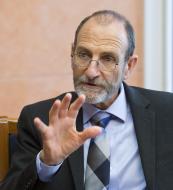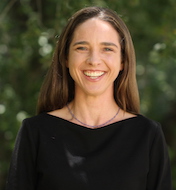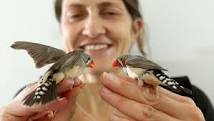What are top world scientists telling government about climate extremes? How dangerous is our current situation? From Carnegie at Stanford, Dr. Chris Field and Dr. Katharine Mach on latest. Plus Dr. Mylene Mariette: what birds tell eggs about a hotter world.
Download or listen to this program in CD Quality (56 MB) or Lo-Fi (14 MB)
LISTEN NOW
CD Quality
Audio Player
Lo-Fi
Audio Player
Welcome back to another season of Radio Ecoshock. I’m your persistent collector of voices, Alex Smith.
Ten years ago when I began broadcasting this program, my goal and my passion was to save humanity and the creatures from dangerous climate change. I would do it by presenting proven facts, as published by science, with illumination from authors, and the example of brave activists.
All that has failed. We are still in a car hurtling toward the cliff of a terrible shift in climate. We are still debating whether to take our foot off the accelerator, much less hit the brakes. That is because we are addicted not just to fossil fuels, but to energy slaves. All of us. Me too.
The most experienced scientists, even the heads of most governments, know we are headed into very dangerous climate disruption. I wondered what the only world body formed to address this, the Intergovernmental Panel on Climate Change would do.
It turns out that body just held an introductory meeting in Geneva this past August. It’s a “scoping meeting” – laying out the groundwork for a report due out in 2018. The subject: the grave risks of a world 1.5 degrees hotter than the days before we began this mass industrial experiment. As you’ll hear, we have already breached that danger line, at least for part of 2016.
TITLE: IPCC Working Group I (GW I) “The Physical Science Basis”
World Meteorological Organization, Geneva, Switzerland
15-18 August 2016
SCOPING MEETING BACKGROUND DOCUMENT
HOW THIS MEETING CAME ABOUT (Quoting from the Scoping Document)
“As part of the COP21 Paris agreement, the UNFCCC invited the IPCC to develop a Special Report in 2018 on the impacts of global warming of 1.5°C above pre-industrial levels and related global greenhouse gas emission pathways. The IPCC accepted the UNFCCC’s invitation at its 43rd Session (11-13 April 2016, Nairobi, Kenya), noting the context of strengthening the global response to the threat of climate change, sustainable development and efforts to eradicate poverty.”
THEY KNOW A RAPID TRANSITION IS NEEDED
“This invitation builds partly on the 2013-2015 Structured Expert Dialogue (SED) between experts and Parties to the UNFCCC. This dialogue concluded that… limiting global warming to below 2°C
necessitates a radical transition through deep decarbonization starting now and going forward, not merely a fine tuning of current trends.”
This week we hear from two of the top level scientists advising governments, via the IPCC. These are the big picture experts who assess extreme weather events. And as we’ll talk about next week, there are plenty of extreme weather events happening around the world.
FIRST GUEST OF 2016: DR. CHRIS FIELD, FROM STANFORD

Dr. Chis Field, Stanford
Here is the short online bio quoted from the web site for my first guest, the distinguished scientist Dr. Chris Field:
“Chris Field is the founding director of the Carnegie Institution’s Department of Global Ecology and Melvin and Joan Lane Professor for Interdisciplinary Environmental Studies at Stanford University. Field’s research emphasizes field and laboratory studies of impacts of climate change, from the molecular to the global scale. He was, from 2008 to 2015, co-chair of Working Group II of the Intergovernmental Panel on Climate Change, which led the effort on the IPCC Special Report on “Managing the Risks of Extreme Events and Disasters to Advance Climate Change Adaptation” (2012) and Working Group II contribution to the IPCC Fifth Assessment Report (2014). Field’s research has been recognized with several American and international awards, including the Max Planck Research Award and the Roger Revelle Medal, and with election to learned societies, including the US National Academy of Sciences (2001). Field received his PhD from Stanford in 1981 and has been at the Carnegie Institution for Science since 1984.”
SECOND GUEST: DR. KATHARINE MACH (also of Stanford)

Katharine Mach, Stanford
Our second guest, Dr. Katharine Mach has also been deeply involved in the Working Group II of the Intergovernmental Panel on Climate Change. She just attended the IPCC Scoping Meeting on 1.5 degrees C of warming, planning a major report for 2018. The report will also include the link of climate to extreme weather events.
We get a report on that meeting in Geneva this August, plus a look into how the masses of new scientific papers are brought together, into a summary that policy makers (and perhaps even top politicians) can understand and deal with. It’s a daunting task, involving co-ordination with thousands of scientists. Katharine is in the thick of it – and she’s a “big-picture” person.
THE SENDAI FRAMEWORK FOR DISASTER RISK REDUCTION
During the interview with Katharine, we talk about “the Sendai Framework for Disaster Risk Reduction”.
That is found here and described here in Wikipedia.
“The Sendai Framework for Disaster Risk Reduction (2015-2030) is an international Treaty which was approved by UN member states between 14th and 18th of March 2015 at the World Conference on Disaster Risk Reduction held in Sendai, Japan.”
Wikipedia continues:
The Sendai Framework sets four specific priorities for action:
Understanding disaster risk;
Strengthening disaster risk governance to manage disaster risk;
Investing in disaster risk reduction for resilience;
Enhancing disaster preparedness for effective response, and to “Build Back Better” in recovery, rehabilitation and reconstruction.
The Sendai agreement calls to lower both mortality and the number of people affected in the period 2020 to 2030, compared to 205-2015. This means we must know those numbers for 2005-2015 (not widely known). Is this lowering likely given the increasing intensity of weather events, plus heat, drought, fires, storm surge and the huge unknown of the response of the insect world and the microbiology of diseases to climate disruption?
We also discuss “blue carbon” as part of the solution to avert climate disaster.
WHAT IS THE “BLUE CARBON” IDEA?
“Blue carbon is the carbon captured by the world’s oceans and coastal ecosystems. The carbon captured by living organisms in oceans is stored in the form of biomass and sediments from mangroves, salt marshes, sea grasses and potentially algae.”
See also: http://thebluecarboninitiative.org/
NEW SCIENCE: BIRDS CAN TELL CHICKS IN THE EGGS ABOUT A WARMING WORLD
Can your baby hear and learn in the womb? Yes. That is true of many species. Can the unborn learn about climate change? Apparently so, as shown by a new scientific study in Australia. We’ll go to the lead author, Mylene Mariette. She’s the Alfred Deakin Postdoctoral Research Fellow at the Centre for Integrative Ecology, at Deakin University in Melbourne Australia.

The actual paper is titled: “Prenatal acoustic communication programs offspring for high posthatching temperatures in a songbird” with Mylene M. Mariette as lead author, with co-author Katherine L. Buchanan. You can find the abstract here.
I found this paper interesting for many reasons. First – who knew birds could talk to chicks in the egg? I ask how un-born birds can hear.
Then, how did Mylene stumble upon this strange fact? She and her co-workers were recording the chatter of the Desert Finch, a common bird in Australia. Of course the male and female chirped to each other. But then the scientists found that whoever was tending the nest (both sexes do) – was also talking alone. They communicated when the weather was hotter than the high 70’s Fahrenheit. Apparently, they warned the chicks to expect hot weather.
How do we know? The team compared the offspring of birds who talked to their eggs when hot, with those who did not. The chicks that were warned came out smaller. You may think that’s a bad sign. Actually, all kinds of species become smaller as the climate gets hotter. It’s a survival strategy and it works. The “warned” birds had more off-spring.
Listen in, it’s an intriguing snapshot of how some species (not all birds do this) might adapt to a hotter world.
We’ll all have to learn how to adapt to a hotter world. Maybe we should be warning our own babies?
My special thanks to all those who supported this program during the summer with their monthly donations. That paid the bills, even while I was away tending my garden, seeing my relatives, and plotting a new season.
Tune in next week, for more Radio Ecoshock.
Hope you had a good break Alex. Your show is amazing – you say “all this has failed”, but I’m not sure that’s true. Surely many people have been enlightened by your show. Even if on your own you can’t save the planet, you’re sure doing a great job regardless.
Your show was one of the key things that pushed me into realising the seriousness of climate change, just a few months ago.
It was a tough and heavy realisation, but now I’m talking about the climate with friends, getting involved in activism and trying to reduce my own carbon footprint.
I’m not saying I’m doing anything like enough, but I wanted to give a small example that hopefully shows your work is having an impact.
Thank you so much!
I have to question the perspective of Dr. Chris Field. He seems too much an apologist for fossil fuel powered industries and lifestyles. He also seems soft on nuclear power. He presents a fairly precise assessment of climate change, but he is so uncertain on remediation possibilities and really avoids stating directly that fossil fuel burning must go. It seems he is walking a political tightrope so as to retain his IPCC position. We have to infer which information from the IPCC is reliable and which is is political necessity.